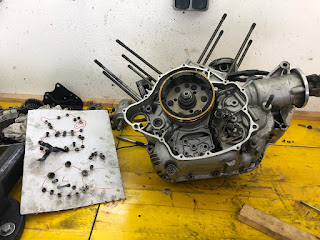As the title suggests, it's one of those instances, where I am my own worst enemy. Ever since I assembled the engine, I disliked the fact that I installed one subpar crankshaft roller bearing. It would most likely have been fine, but it has bugged me for about a month or so until I finally gave in and accepted that I won't be happy until I know for sure that the bottom end of of this engine is solid.
But first, I had to swap out the rear wheel for an XJ650 rear-wheel, so I can run the bike with the stock brake configuration and pass an MOT with it.
About one and a half hours later, the bike was well in bits, the engine on the bench and the crankshaft roller bearing sharing a tray with some frozen veggies in my dad's freezer.
The following day I turned my attention towards taking the engine apart, which quite frankly, if you've done it as often as I have, it was roughly a one hour job.
The only tricky part this time probably was that I had to access two bolts hidden behind the oilpump, without taking the oilpump out entirely
Luckily the crankshaft bearing in question was the right one.
As a wise Ozzy once said: it's never too late for a proper barbie... (seriously though, my dad's oven was too small to get half the crankcase in. Heated it up to a solid 160 degrees C and chilled the bearing to around -30 or thereabouts.
... and it fell into the case with the most satisfying *clunk* one can imagine.
Following the legendary (and stupid) phrase from the book of lies: assembly is the reverse process of disassembly. I tried out Loctite liquid gasket for the first time and by now I am not entirely sure, if I like it or not as it is a lot thicker and once dry it's almost impossible to remove. (Something I liked a lot about Dirko - 24h after application you sprayed it down with some brake-cleaner and you could just peel off the excess material. On the other hand, this probably also means it stays put better inside the engine. Either way, I think it will work brilliantly for glueing on rubber grips.
As I had collected a few more bits, all the necessary ones for a 9-disk-clutch are in my possession now. So first cut the posts to length...
... then mill them, so they are the same length as the basket ...
and ultimately mill out another section of the outer basket, so trapped oil can escape quicker between the clutch plates.
And oh yes, I love the new mill. So what's to be expected in the next post? A frame swap and repaint, a modified center stand and surely some other things as I come along the way. I may say I am a bit excited as the first noises aren't all that far away.





















